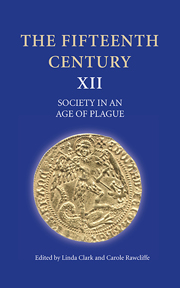Book contents
- Frontmatter
- Contents
- List of Illustrations
- Contributors
- Preface
- Abbreviations
- Introduction
- Looking for Yersinia Pestis: Scientists, Historians and the Black Death
- Pestilence and Poetry: John Lydgate's Danse Macabre
- Pilgrimage in ‘an Age of Plague’: Seeking Canterbury's ‘hooly blisful martir’ in 1420 and 1470
- An Urban Environment: Norwich in the Fifteenth Century
- Mid-Level Officials in Fifteenth-Century Norwich
- Leprosy and Public Health in Late Medieval Rouen
- Plague Ordinances and the Management of Infectious Diseases in Northern French Towns, c.1450–c.1560
- The Renaissance Invention of Quarantine
- Coping with Epidemics in Renaissance Italy: Plague and the Great Pox
- The Historian and the Laboratory: The Black Death Disease
- Index
- CONTENTS OF PREVIOUS VOLUMES
The Renaissance Invention of Quarantine
Published online by Cambridge University Press: 05 September 2013
- Frontmatter
- Contents
- List of Illustrations
- Contributors
- Preface
- Abbreviations
- Introduction
- Looking for Yersinia Pestis: Scientists, Historians and the Black Death
- Pestilence and Poetry: John Lydgate's Danse Macabre
- Pilgrimage in ‘an Age of Plague’: Seeking Canterbury's ‘hooly blisful martir’ in 1420 and 1470
- An Urban Environment: Norwich in the Fifteenth Century
- Mid-Level Officials in Fifteenth-Century Norwich
- Leprosy and Public Health in Late Medieval Rouen
- Plague Ordinances and the Management of Infectious Diseases in Northern French Towns, c.1450–c.1560
- The Renaissance Invention of Quarantine
- Coping with Epidemics in Renaissance Italy: Plague and the Great Pox
- The Historian and the Laboratory: The Black Death Disease
- Index
- CONTENTS OF PREVIOUS VOLUMES
Summary
In 1405, Pietro Filargo (1339–1410) – who was Milan's archbishop, the tutor and ambassador for Giovanni Galeazzo Visconti and future Pope Alexander V – described that city in painful terms. He wrote,
How can things go well in this most miserable Milan, full of the poor, famished and pestilent who wander through the city showing spots and sores while so great and even adequate provisions are cruelly embezzled? The souls of benefactors are being damned, for no one prays for them any longer, no one gives charity any longer and the souls of those who do not respect the wishes of the dead are also damned. And it is for such great impiety that God, with his three whips of hunger, war and plague, has inflicted Milan with these apocalyptic punishments [apocalittici castighi].
In spite of changes in the centralised administration of charity in the early years of the fifteenth century in this Italian city state, it was recognised that more needed to be done. The consequences of inaction, as described by Filargo, were great: eternal damnation for the dead and earthly suffering for the living. In particular, he noted the increased regularity of famine, warfare and plague as natural signs of an impending apocalypse; for Filargo, as for many of his contemporaries, the issues of charitable care and natural disasters were intertwined.
- Type
- Chapter
- Information
- The Fifteenth Century XIISociety in an Age of Plague, pp. 161 - 174Publisher: Boydell & BrewerPrint publication year: 2013



